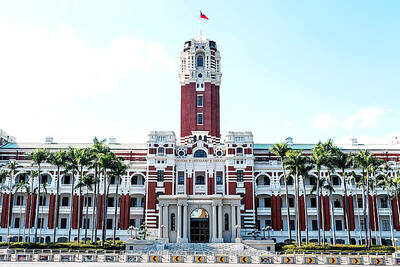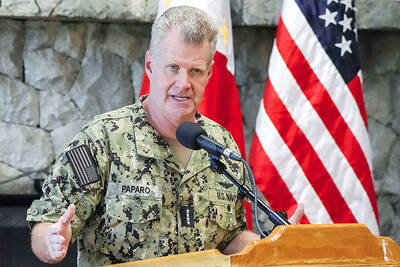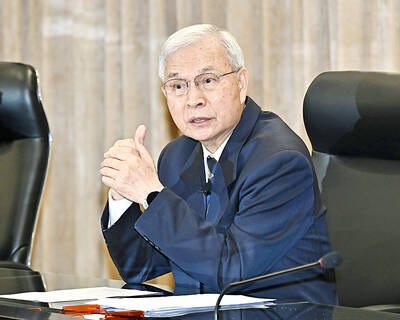Myanmar declared victory yesterday for a military-backed constitution, pressing ahead with its political agenda despite the devastation caused by the cyclone that left 133,000 dead or missing.
Though more than half of the 2.4 million people severely affected by the cyclone have not yet been reached by international aid, the ruling junta claimed nearly all of them cast a ballot.
“The suggestion that the areas affected by the cyclone got 93 percent turnout just highlights what nonsense the process is,” said John Virgoe, Southeast Asia director for International Crisis Group.
“The way this has been done can’t in any way represent the true wishes of the people because it wasn’t a free and fair vote,” he said.
Cyclone Nargis pounded the country more than three weeks ago, destroying entire villages in the Irrawaddy Delta area in the country’s southwest and pounding the main city of Yangon.
Some 4.5 million voters in the cyclone zone were eligible to cast ballots on Saturday in a second round of voting. State media said 93 percent turned out for the poll, with 92.93 percent endorsing the charter.
A first round of voting had been held on May 10 in regions spared by the storm.
Nationwide, state media said the constitution was approved by 92.48 percent, with a 98 percent turnout.
Myanmar ignored international calls to delay the referendum and those whose homes had been destroyed said they were forced out of schools where they had sought shelter so classrooms could be used as polling stations.
The US said on Sunday it was “dismayed” that Myanmar’s military rulers had held the second round of voting in regions still devastated by the cyclone.
“The United States is dismayed by the fact that, in the midst of a major humanitarian disaster, in which a majority of those affected have not received assistance yet, the Burmese regime conducted on May 24 a second round of voting on its draft constitutional referendum in the five regions affected by the cyclone,” State Department deputy spokesman Tom Casey said in a statement.
Meanwhile, UN chief Ban Ki-moon headed back to New York yesterday, saying he hoped the junta would honor its promise to open up cyclone-devastated areas of the country to foreign aid workers.
Ban’s mission to knock down Myanmar’s barriers to international cyclone assistance climaxed on Sunday when donor nations offered more than US$100 million to help the country recover from Nargis.
But they warned the ruling generals they would not fully open their wallets until they were given access to the hardest-hit areas.
“We have seen that the Myanmar government is moving fast to implement their commitment. My sincere hope is that they will honor their commitment — that we have to see,” Ban told reporters before leaving Bangkok for New York on Sunday night.
How quickly Myanmar embassies around the world issue visas to international aid workers lining up to enter the country will be an important litmus test of the junta’s sincerity in allowing access.
Also See: Giving without seeking in return

The CIA has a message for Chinese government officials worried about their place in Chinese President Xi Jinping’s (習近平) government: Come work with us. The agency released two Mandarin-language videos on social media on Thursday inviting disgruntled officials to contact the CIA. The recruitment videos posted on YouTube and X racked up more than 5 million views combined in their first day. The outreach comes as CIA Director John Ratcliffe has vowed to boost the agency’s use of intelligence from human sources and its focus on China, which has recently targeted US officials with its own espionage operations. The videos are “aimed at

STEADFAST FRIEND: The bills encourage increased Taiwan-US engagement and address China’s distortion of UN Resolution 2758 to isolate Taiwan internationally The Presidential Office yesterday thanked the US House of Representatives for unanimously passing two Taiwan-related bills highlighting its solid support for Taiwan’s democracy and global participation, and for deepening bilateral relations. One of the bills, the Taiwan Assurance Implementation Act, requires the US Department of State to periodically review its guidelines for engagement with Taiwan, and report to the US Congress on the guidelines and plans to lift self-imposed limitations on US-Taiwan engagement. The other bill is the Taiwan International Solidarity Act, which clarifies that UN Resolution 2758 does not address the issue of the representation of Taiwan or its people in

US Indo-Pacific Commander Admiral Samuel Paparo on Friday expressed concern over the rate at which China is diversifying its military exercises, the Financial Times (FT) reported on Saturday. “The rates of change on the depth and breadth of their exercises is the one non-linear effect that I’ve seen in the last year that wakes me up at night or keeps me up at night,” Paparo was quoted by FT as saying while attending the annual Sedona Forum at the McCain Institute in Arizona. Paparo also expressed concern over the speed with which China was expanding its military. While the US

SHIFT: Taiwan’s better-than-expected first-quarter GDP and signs of weakness in the US have driven global capital back to emerging markets, the central bank head said The central bank yesterday blamed market speculation for the steep rise in the local currency, and urged exporters and financial institutions to stay calm and stop panic sell-offs to avoid hurting their own profitability. The nation’s top monetary policymaker said that it would step in, if necessary, to maintain order and stability in the foreign exchange market. The remarks came as the NT dollar yesterday closed up NT$0.919 to NT$30.145 against the US dollar in Taipei trading, after rising as high as NT$29.59 in intraday trading. The local currency has surged 5.85 percent against the greenback over the past two sessions, central